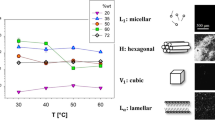Abstract
The nonlinear electrorheological (ER) behavior of nonionic surfactant-activated ER suspensions is investigated. The influence of three nonionic surfactants (Brij®30, GMO, and GTO) on the electrorheological (ER) response of various alumina/silicone oil suspensions shows similar behavior. The prevalent feature common to all formulations is that the yield stress, τ0, initially increases with surfactant concentration, passes through a maximum, then decreases with surfactant concentration. The nonlinear behavior observed at large surfactant concentrations (i.e., τ0≈En;, where n>2) arises from field-induced phase separation of a surfactant-rich phase as opposed to field-dependent conductivity of a homogeneous continuous phase.
Similar content being viewed by others
References
Anderson, R. A., “Electrorheological Fluids”, (Tao, R., Ed.), World Scientific, Singapore, 81 (1992).
Anderson, R. A., “Electrostatic Force in an Ideal Spherical-Particle Electrorheological Fluids”,Langmuir,10, 2917 (1994).
Block, H. and Kelly, J. P., “Electro-rheology”,J. Phys. D: Appl. Phys.,21, 1661 (1988).
Brosseau, C., “Electrical Conduction in Impregnants for Allfilm Power Capacitors”,J. Appl. Phys.,70, 5544 (1991).
Davis, L. C., “Finite-element Analysis of Particle-particle Forces in Electrorheological Fluids”,Appl. Phys. Lett.,60, 319 (1992).
Deinega, Y. F. and Vinogradov, G. V., “Electric Fields in the Rheological Disperse System”,Rheol. Acta,23, 636 (1984).
Felici, N., Foulc, J. N. and Atten, P., “Electrorheological Fluids: Mechanisms, Properties, Technology, and Applications” (Tao, R. and Roy, G. D. Eds.), World Scientific, Singapore, 139 (1994).
Felici, N., “High-field Conduction in Dielectric Liquids Revisited”,IEEE Trans. Elect. Insul.,1, 233 (1985).
Gast, A. P. and Zukoski, C. F., “Electrorheological Fluids as Colloidal Suspensions”,Adv. Coll. Int. Sci.,30, 153 (1989).
Jordan, T. C. and Shaw, M. T., “Electrorheology”,IEEE Trans. Elect. Insul.,24, 849 (1989).
Kim, Y. D., “Non-ionic Surfactant-Activated Electrorheological Suspensions”, Ph.D. Thesis, U. of Wisconsin, 1996.
Klingenberg, D. J. and Zukoski, C. F., “Studies on the Stedyshear Behavior of Electrorheological Suspensions”,Langmuir,6, 15 (1990).
Rosen, M. J., “Surfactants and Interfacial Phenomena”, 2nd ed., Wiley, New York, 1989.
Shulman, Z. P., Gorodkin, R. G., Korobko, E. V. and Gleb, V. K., “The Electrorheological Effects and Its Possible Uses”,J. Non-Newt. Fluid Mech.,8, 29 (1981).
Weiss, K. D. and Carlson, J. D., “Material Aspects of Electrorheological Systems”,J. Intell. Sys. and Struct.,4, 13 (1993).
Winslow, W. M., “Induced Fibration of Suspensions”,J. Appl. Phys.,20, 1137 (1949).
Zhu, B. Y. and Gu, T., “Surfactants Adsorption at Solid-liquid Interface”,Adv. Coll. Int. Sci.,37, 1 (1991).
Author information
Authors and Affiliations
Rights and permissions
About this article
Cite this article
Kim, Y.D., Klingenberg, D.J. The nonlinear behavior of surfactant-activated electrorheological suspensions. Korean J. Chem. Eng. 14, 23–29 (1997). https://doi.org/10.1007/BF02706037
Received:
Accepted:
Issue Date:
DOI: https://doi.org/10.1007/BF02706037




